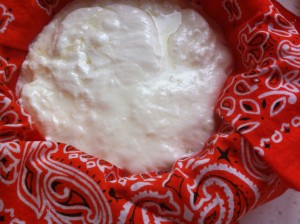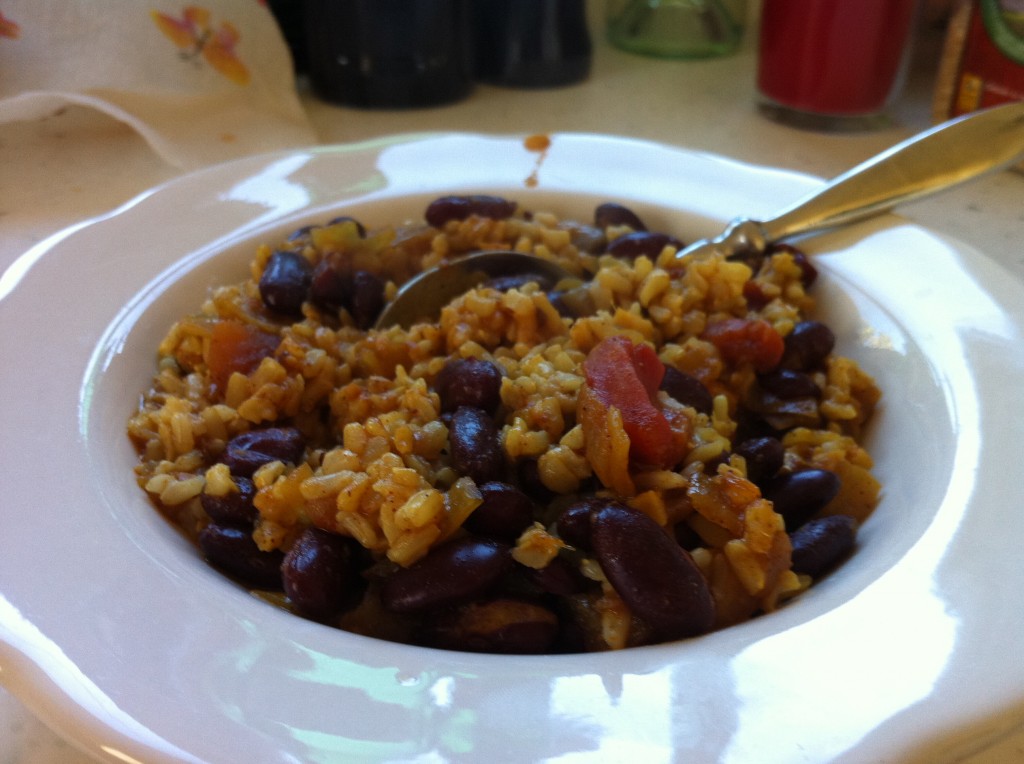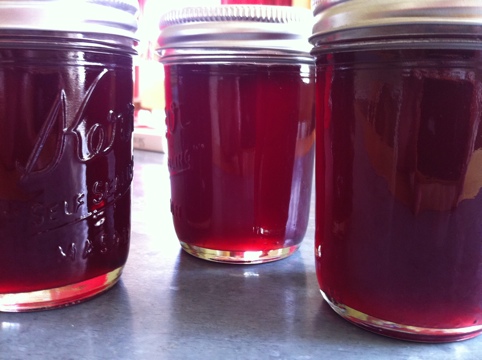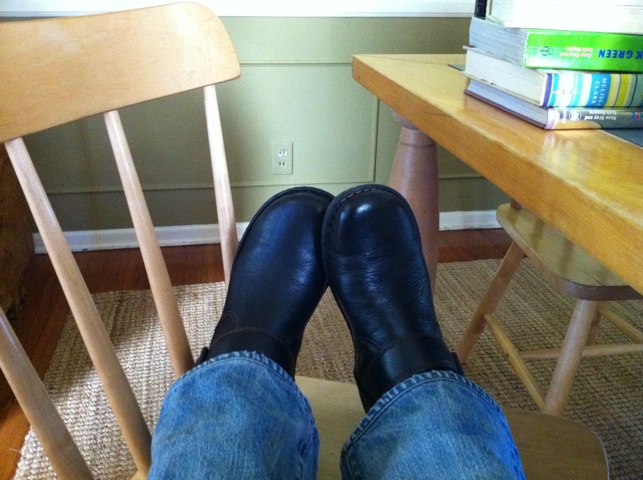 Everyone knows that the real New Year starts in February, right? January is just sort of a warm up. Maybe you brainstorm about various resolutions and plans. Maybe you just kinda get started and are working out the kinks. It’s practice. But February is for reals: you can’t say you just got back from vacation or you’re just getting over the holidays – that stuff is done. February is like 4:00 a.m. – nothing is going on. It’s just you and your whirring brain, saying, “Are you going to make this year work – or what?”
Everyone knows that the real New Year starts in February, right? January is just sort of a warm up. Maybe you brainstorm about various resolutions and plans. Maybe you just kinda get started and are working out the kinks. It’s practice. But February is for reals: you can’t say you just got back from vacation or you’re just getting over the holidays – that stuff is done. February is like 4:00 a.m. – nothing is going on. It’s just you and your whirring brain, saying, “Are you going to make this year work – or what?”
 And so it’s the perfect time to get started in earnest with the 30 Large Project. No more excuses. No monkeying around. But I’m not worried. It won’t be hard – like climbing Mount Everest or running for president. This is just being responsible. No biggie.
And so it’s the perfect time to get started in earnest with the 30 Large Project. No more excuses. No monkeying around. But I’m not worried. It won’t be hard – like climbing Mount Everest or running for president. This is just being responsible. No biggie.
 Throughout the month of February, we pledge to only spend money on “needs” (as defined by our guru Elizabeth Warren in her book, All Your Worth), such as food, gasoline, and things we are contractually required to pay, such as mortgage, cable, credit card balances, etc. We will also keep track of every penny spent, so as to begin to get a crystal clear picture of where the money goes, even when we are really thinking about it and being on our best behavior.
Throughout the month of February, we pledge to only spend money on “needs” (as defined by our guru Elizabeth Warren in her book, All Your Worth), such as food, gasoline, and things we are contractually required to pay, such as mortgage, cable, credit card balances, etc. We will also keep track of every penny spent, so as to begin to get a crystal clear picture of where the money goes, even when we are really thinking about it and being on our best behavior.
 When it comes to our (historically) monstrous food budget and my Whole Foods addiction, I expect to keep to my budget of $100 a week, not including our delicious weekly CSA box. This is going to be the tough part for me as I think a significant portion of our food – that is in excess of our $100 weekly limit – now comes from the “wants” column. Expect to see lots of cheap recipes from Nerdhaven West in February!
When it comes to our (historically) monstrous food budget and my Whole Foods addiction, I expect to keep to my budget of $100 a week, not including our delicious weekly CSA box. This is going to be the tough part for me as I think a significant portion of our food – that is in excess of our $100 weekly limit – now comes from the “wants” column. Expect to see lots of cheap recipes from Nerdhaven West in February!
 We will report back on the blog each week with a summary, describing the ups and downs and what we have done and learned. We will not publish a spreadsheet (although we have had requests to do that!) but we will try to get to the details as closely as possible so you can feel our pain . . . um, I mean responsibility . . . no – I mean our frugaliciousness.
We will report back on the blog each week with a summary, describing the ups and downs and what we have done and learned. We will not publish a spreadsheet (although we have had requests to do that!) but we will try to get to the details as closely as possible so you can feel our pain . . . um, I mean responsibility . . . no – I mean our frugaliciousness.
 P.S. Who says frugaliciousness isn’t all that photogenic? All the photos in this post are of free things around my house. And because you have made it this far in the post, I will reward you with a video of chickens arguing over string cheese. Click here: LoudMo
P.S. Who says frugaliciousness isn’t all that photogenic? All the photos in this post are of free things around my house. And because you have made it this far in the post, I will reward you with a video of chickens arguing over string cheese. Click here: LoudMo
Tag Archives: Diane
Fresh and Exciting
So we are doing taxes and financial aid forms for colleges ($55K a year for college! Really? Just in case there wasn’t enough of a divide between the 99 percent and the 1 percent . . . sheesh don’t get me started). We are up to our eyeballs in money talk these days. So for a minute or two I am going to put off the actual hard-core analysis of breaking down our finances and skip to healthy, simple (and cheap) food, which is what I’m trying to work on every day, anyway.
 I’m trying the basics: Living my life responsibly and making my own stuff, when I can – and trying to learn something new every day. Recently, I learned that I can make yogurt. This is not trumpets-blaring news, I know. But it’s exciting for me . . . I finally did it after wondering about it for, like, ever.
I’m trying the basics: Living my life responsibly and making my own stuff, when I can – and trying to learn something new every day. Recently, I learned that I can make yogurt. This is not trumpets-blaring news, I know. But it’s exciting for me . . . I finally did it after wondering about it for, like, ever.
Folks have been making yogurt – in a zillion different forms – all over the world for generations upon generations, probably as long as mammals, bacteria and humans have co-existed. (I’m picturing the first moment of yogurt – some suspicious wife passes some old, curdled milk toward her husband and says, “Taste this – is it still good?”) I am happy – okay, proud – to now be part of the flow of the history’s yogurt-making peoples.
I can’t believe it took me this long to try yogurting myself. This is easy, tasty and cheap – just like they did it in the old country. It is really a testament to the power of marketing that we all go out and buy this stuff when it is so easy and soooo much tastier to make it at home. This yogurt does not resemble the typical grocery store kind at all. It’s more like what you’d get from Greek yogurt – but the flavor is not just tangy, it’s delicious. Maybe because it is made so fresh.
 Yogurt
Yogurt
Adapted from Milk: The Surprising Story of Milk Through the Ages by Anne Mendelson (Although the recipe is all over the place, I like to cite a reliable source.)
If you and/or your family are not yogurt freaks, like we are, you could just cut this recipe in half. It works just fine and heats and cools faster.
Ingredients:
1/2 gallon whole or 2 percent milk
3 tsp. plain unflavored yogurt with active cultures
Equipment:
2 quart-sized glass jars
Gas oven with pilot light (or not, see Note below)
Candy thermometer (or you can just eyeball it)
1. Heating/Cooling: Pour the milk into a heavy saucepan. Attach the candy thermometer, if using. Heat to 180F (until it’s just about to boil). Take the milk off the heat and cool to 110 º F (not quite hot to the touch). You can put your pot in a larger bowl with ice water to speed up the process to 10-15 minutes or so. Or you can just let the milk cool on its own (while you watch the Daily Show, for example) for 25-30 minutes or so.
2. Inoculating: Put 3 Tbsp. of store-bought yogurt in a small bowl and stir about 1 cup of the milk into it. Then stir this mixture back into the pot of milk.
3. Incubating: Pour the milk into the two quart-sized glass jars. Gently place the two jars in the oven – no need to cover – and then do not disturb or jiggle or bounce or jounce or anything for 6 -7 hours. My routine is to make this overnight – the kitchen is quiet, and I get to cook while I sleep. Nice.
4. Waking: In the morning, shuffle into the kitchen to find two containers of yogurt in the oven! I save one to use in smoothies (awesome – although what will I do without that constant stream of 32 oz. plastic yogurt containers coming into my life?). With the second container, I move onward – and upward – to step 5.
5. Draining: This step isn’t necessary if what you are want is a yogurt to use in smoothies, or if texture is not a big deal to you. But if you want a hauntingly delicious yogurt to eat with honey or preserves, or to use in a dip or salad – you really must drain it. Once I tasted the drained yogurt – I couldn’t get the taste out of my head. I wanted more . . . Here’s the step: Line a strainer with a bandana (see fancy orange bandana in photo above) and place it over a bowl deep enough to catch 4 cups liquid. Then pour the yogurt into the strainer and let sit about 3 hours. Turn the yogurt out into your storage (or serving) container and stir until smooth. Serve yourself some yogurt right away, spoon some honey on top and . . . prepare to have your mind blown. Enjoy.
Note: Denise has joined the yogurt-making flow by making yogurt without a pilot-lit oven. You go girl! Just use a hot-cold plastic container, or wrap the jars in towels and put them in a cooler. Whatever it takes to keep the incubating yogurt cozy at 110 º F. If the temperature drops below 110 º F, the yogurt will be thinner or take longer to set. But as long as you have the active starter and a peaceful place for the yogurt to incubate – yogurt will happen.
P.S. Making yogurt at home is also – big surprise – cheaper than buying it at the store. Two quarts of this yogurt cost me $3.00 to make (I used 1/2 gallon of organic milk, which I buy at Trader Joe’s for $5.99/gallon). While the price for one quart of organic yogurt at TJ’s is $2.99. So I am getting two for the price of one by making my own. True – when I don’t buy the yogurt at the store I do not get the quite useful plastic tub it comes in . . . but I will trade the tub out for being that much closer to saving 30 Large.
P.P.S. Did you like my old-school yogurt photo? I took the photo on my phone and old-schooled it on this cool Japanese site. I’m going there now to make all my photos old.
Take it Easy
I am writing this post while standing on a corner in Winslow, Arizona. Not really. I am trying to take Glenn Frey’s recommendation and “take it easy.” In my mind, I am right here, chillin out:
 Image by Rogie 09 via Flickr
Image by Rogie 09 via Flickr
As part of the 30 Large Project, I have decided to try to feed my family of four for $650 a month. “Whoa!” I hear from my friends, “That is hard!” I’m thinking no: climbing Mount Everest is hard. Running for President is hard. Grocery shopping is not hard.
Rather than adopting an excuse why I can’t feed my family more cheaply (like, it’s hard), I’m proceeding with the attitude that it’s easy. Why not? Food is not rocket science (which, I hear, is actually not all that hard).
Taking the easy route, I’m starting with rice and beans – it’s not like I’m going to make this cheap eating stuff work with filet mignon. I’m also starting with Indian food: flavorful, lots of veggie options (veggies being cheaper than meat), and our kids really like it. It’s probably the #1 thing they fell in love with on their trip to London a couple summers ago. No, not the Tower of London or scones or theater: Indian food was the take away . . .
So I got an Indian food cookbook, Vij’s at Home: Relax, Honey (even the title seems to take it easy). We have been to Vij’s restaurant in Vancouver, B.C., and had the greatest time, so I was happy to get the chance to try some of their food at home. Turns out, Indian food is super cheap – and can be easy to make as well. Funny, I always thought making Indian food was hard – you know, like ending global warming.
Back to rice and beans. I made their Rajmal Chawal (aka kidney beans and rice). It was delicious. We ate it for dinner (with a veggie alongside) and then we had enough for several lunches of leftovers. See? Cheap and easy.
 Kidney Beans and Rice aka Rajma Chawal
Kidney Beans and Rice aka Rajma Chawal
Adapted from Vij’s at Home: Relax, Honey by Meeru Dhalwala & Vikram Vij
The first time I made this, I made it exactly as the recipe instructed, but I thought – while it was super yummy – it was too watery and too spicy. We also really like ginger, so I added extra. I have given you my preferred measurements here. Feel free to add more cayenne (up to 1t) and more water (up to 6 cups) if you want it spicier or soupier. If you (like my sister) are not a fan of kidney beans (as a kid she meticulously removed them from her chili) you can switch out for pinto beans.
I’m not always great with getting the ingredients all ready beforehand, but it is a must with this recipe. Chop the onion, press the garlic, grate the ginger, and measure out all the spices into a small bowl before you heat the oil. It makes this recipe so much easier to put together. And easy is what we are after, after all.
½ cup canola oil
1 large onion, chopped small
2 Tbsp. chopped or pressed garlic
3 Tbsp. grated ginger
1 15 oz. can diced tomatoes
1½ Tbsp. chili powder
1 tsp. turmeric
1 Tbsp. ground cumin
1 Tbsp. ground coriander
1½ tsp. salt
¼ tsp. ground cayenne pepper
½ cup plain yogurt
4 cups water
3 14-oz. cans kidney beans, drained and rinsed
5-6 cups cooked brown basmati rice (next recipe)
Heat oil in a medium pot on medium-high for about 30 seconds. Add onion and sauté until slightly dark brown, about 8-10 minutes. Add garlic and sauté for 2 minutes, then stir in ginger and tomatoes. Add chili powder, turmeric, cumin, coriander, salt and cayenne and sauté this tomato sauce for 5-8 minutes, or “until the oil glistens on top,” as my friends Meeru and Vij say.
Put the yogurt in a small bowl. Spoon about 3 tablespoons of the hot sauce into the yogurt. Stir well, then pour the yogurt mixture into the pot of sauce. Cook for about 2 minutes.
Add water, stir and bring to a boil on high heat. Add kidney beans, stir and bring to a boil again. Reduce the heat to medium and cook for 5 minutes, or more, if you want softer beans. The recipe can be made ahead and reheated after you are done driving your daughter to theater rehearsal.
Serve over Brown Basmati Rice (next recipe) with a spinach salad or another veg on the side.
Brown Basmati Rice
Adapted from Vij’s at Home: Relax, Honey by Meeru Dhalwala & Vikram Vij
The kids used to complain about brown rice, but this stuff they love. The other day when I was cooking this rice, my daughter came home. The first words out of her mouth were, “Omigod, home smells awesome!” Really, what is better than that? You can make it without the cumin seeds and/or onion, but your daughter won’t have the same reaction.
This makes 6-8 cups rice, we always have leftovers, so we can have it with the leftover beans for lunch. When making Rajma Chawal, start the rice first because it takes longer to cook and can sit covered on the stove for awhile.
2 cups brown basmati rice
2 Tbsp. butter or canola oil
1½ tsp. cumin seeds
1 large onion, finely chopped
4 cups water
1 tsp. salt
Place rice in a medium bowl, rinse under cold water and drain. Repeat the rinsing/draining, then set rice aside.
In a large pot over medium heat, melt butter or heat oil for a minute. Add cumin seeds and sizzle for 15 seconds. Add onion and sauté until browned, about 10 minutes.
Add water and salt to the pot, then add rice and stir. Increase heat to high and bring to a boil. Immediately reduce the heat to a simmer, cover and cook for 45 minutes. When the time is up, turn off the heat and keep the lid on. The rice will steam and stay while you finish the beans and/or pick your kid up from basketball practice.
Then when you are done cooking and schlepping kids and eating – go take it easy.
Diane Breaks a Rule
Today I violated what I have long considered to be a cardinal rule: I bought cheap shoes. Boots, actually, which is even worse. Boots are an investment piece.
As long as I can remember, I have had this thing about shoes. I think it’s based on some Miss Diana Vreeland-based rule that one must wear expensive shoes and carry an expensive bag (it’s a cousin to the no white shoes after Labor Day rule).
Why Diana Vreeland’s opinion matters so much to me, I’m not certain. She was a strong, creative and outspoken woman – and I like that in a person. She wrote a classic autobiography and I like that, too. But I don’t live in Miss DV’s world. Anyway, I know that any of my “expensive” shoes would probably still seem cheap to her. It’s not like the shoes I buy are featured in Vogue (although in DV’s defense, she may have said to buy the most expensive shoes one could afford – but then she would also have been likely to be supportive of starving for fashion).
There’s definitely a part of me that understands starving for fashion’s sake. Then there’s the other part of me that gets excited about chickens and edible perennials. I think the chickens win out.
Methinks she is over-pondering the boots – but I’m thinking the cheap boots are a representation of a more mature lifestyle. Mature here means smart and responsible – not crow’s feet and a crepey neck. In the past I have justified these “investment pieces” by saying how long they will last me. For example, the last pair of boots I bought cost a few hundred dollars. But I bought them many years ago – maybe 10. I wore them a lot, they worked with pants and dresses, as work or casual-wear. They were very useful and I certainly got my money’s worth out of them. They are just too high-heeled for me these days. But what if I bought a pair of cheap – but well-made – boots and still wore them for 10 years! Then I could get even more of my money’s worth out of them. This is a revelation to me. And a few hundred dollars I can count towards saving 30 large.
Here I am, rocking my cheap – but well-made – boots:
If you are very nice, maybe in 10 years I will let you see them from the side.
The Road Taken
Today I did not write a summary judgment motion. I did not teach a college course. I did not give calm and kind counsel to ten women taking their first steps to extricate themselves from domestic violence.
What I did today was: make pomegranate jelly. It took the better part of the day – the most productive part of the day. And really, I should include the time to juice those suckers – so two hours of a previous day gets added in as well. And what I have to show for it is: 8 jars of jelly. It’s fairly tasty and the product of our backyard tree – genuine product of Nerdhaven Farms. But still . . . is this all there is?

As I was . . . jelling (i.e., stirring, jell testing, failing jell test, stirring, repeat until loco), I thought of a friend of mine – a law school classmate. He was loving his work as a litigator, even starting his own firm. We had an ongoing conversation about work/life balance. Him having, um, none; and me desperately seeking more – litigation and marriage/parenting being diametrically opposing missions.
I remember him saying how it made no sense for him to do housework, cooking, errands, or whatever, because his time was better spent working, where he earned money to pay people to do those things for him and still came out with a sizable profit. I was repulsed when I tried to imagine living my life that way. I felt he was paying someone to live his life for him.
I wanted to be involved in my whole life – like putting my own damn laundry away. At least I would know where my clothes were and I wouldn’t put my sweater – the favorite one that my husband brought me back from Iceland – in the dryer (have I had experiences with house cleaners? Yes.) I wanted to approach my life from a participant’s standpoint, not from a supervisor’s standpoint. No surprise then that I left that firm and took a few years of Mom-time with my then toddler.
Now several years later, I chose the Mom road again and I am very pleased about it. I know what stuff I have and where it is (for the most part) and how to clean it. That’s not to say I don’t look back: let’s take a moment to acknowledge this housewife business can be totally tedious. But as I think about it, there is very little more tedious (sometimes) than lawyering.
What I am glad about now is I am dealing with the simple, daily consequences of my family’s life. We wear clothes. I wash them. We make messes. I clean them. We own things. I take care of them. We (well, one of us) eats a PBJ almost daily. I make pomegranate jelly. And, because I am my own damn supervisor, I also make chocolate chip cookies just cuz I feel like it:


